Monitoring Beach Shape Development and Sediment Dynamics on a Sandy Beach with Low Anthropogenic Influence
Abstract
1. Introduction
2. Materials and Methods
2.1. Study Area
2.2. Sand Sample and Beach Profiles
2.3. Granulometric Analysis
2.4. Beach Profile Analysis
2.5. Tropical Storms and Hurricanes
3. Results
3.1. Temporal and Spatial Variability
3.2. Textural Parameters of Sediment
3.3. Erosion Versus Accumulation
4. Discussion
4.1. Geomorphologic Variation of the Beach Profile
4.2. Relationship between Granulometric Parameters and Wind
4.3. Relationship between Recovery Time and Hydrometeorological Events
4.4. Relationship between Alongshore Transport Direction and Winds
4.5. Quasi-Equilibrium System
5. Conclusions
- (a)
- Low-energy stage: both mouths of the Marabasco River are closed at this time of the year (Meyer et al., 2006) [13]. Therefore, there is no supply of sediment. The processes of erosion and accumulation are carried out with the previously deposited sediment. There is a quasi-equilibrium between the processes of erosion and accumulation.
- (b)
- Medium-energy stage: both mouths of the Marabasco River are open. There is a large supply of sediment to Playa del Coco. This material is mostly deposited on the beach, although a part of it can go to the ocean. Destructive and constructive processes are present, although the latter dominate over the former.
- (c)
- High-energy stage: both mouths of the Marabasco River are open, and since the energy of the river and the supply of sediments to Playa del Coco is greater than it is in the medium-energy stage, erosion of the previously deposited material occurs. The loss of sediment on the beach is greater than the supply of the Marabasco River, and it is assumed that a large part of the supply of the Marabasco River could be deposited in submerged sandbars. The first dune cordon disappears.
Author Contributions
Funding
Data Availability Statement
Acknowledgments
Conflicts of Interest
Appendix A

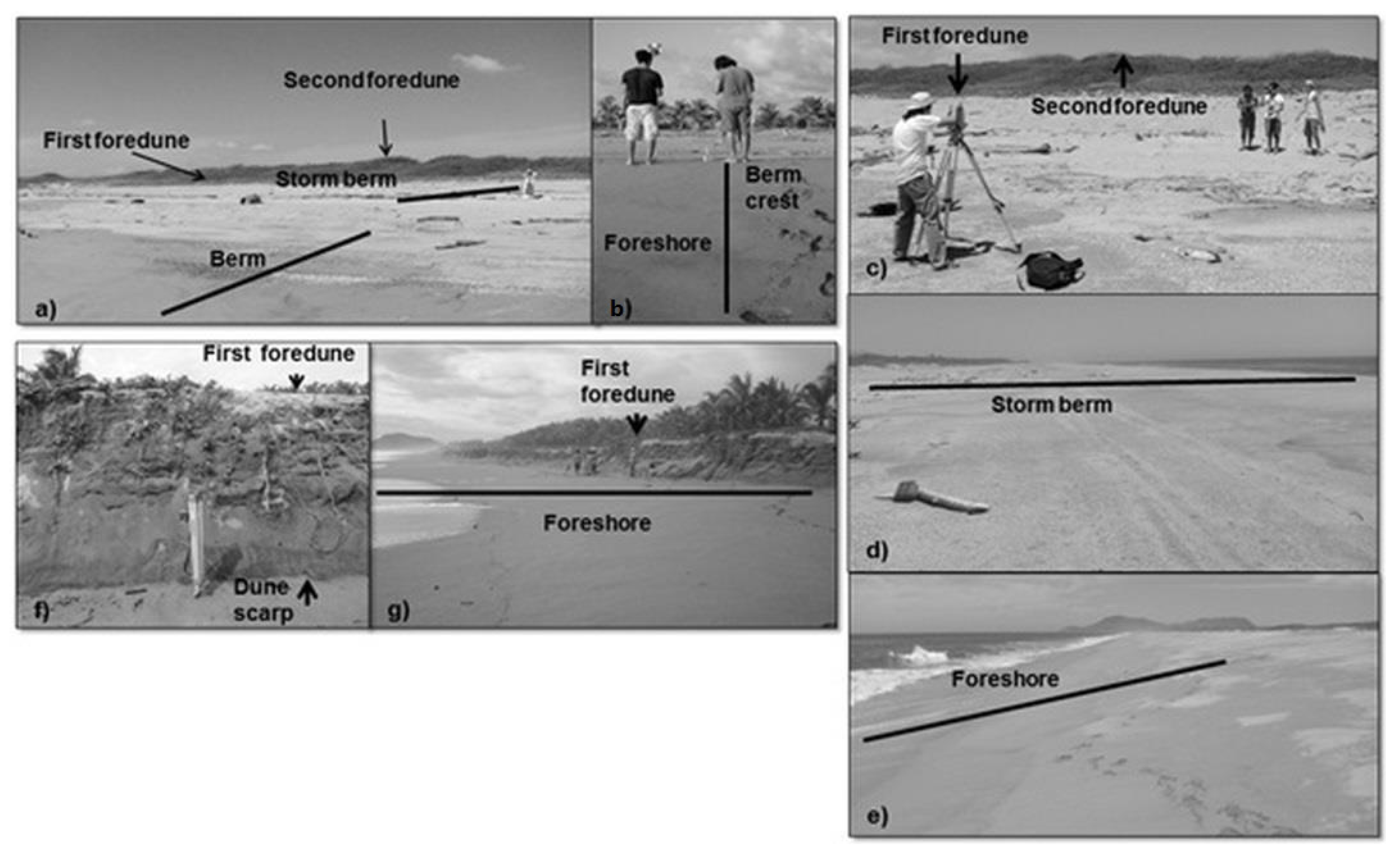
References
- Cabrera-Ramirez, M.; Carranza-Edwards, A. The beach environment in Mexico as a potential source of placer minerals. Mar. Georesources Geotechnol. 2002, 20, 187–198. [Google Scholar] [CrossRef]
- Tarbuck, J.; Lutgens, F.; Tasa, D. Aguas subterráneas. In Ciencias de la Tierra: Una Introducción a la Geología Física, 11th ed.; Martín-Romo, M., Vázquez, M., Eds.; Pearson/Prentice Hall: Madrid, Spain, 2013; pp. 559–572. [Google Scholar]
- U.S. Army Corps of Engineers. Coastal Geology, 1st ed.; U.S. Army Corps of Engineers: Washington, DC, USA, 1995; p. 297. [Google Scholar]
- Larson, M.; Kraus, N.C. Temporal and spatial scales of beach profile change, Duck, North Carolina. Mar. Geol. 1994, 117, 75–94. [Google Scholar] [CrossRef]
- Nordstrom, C.E.; Inman, D.L. Sand Level Changes on Torrey Pines Beach, California; USACE: Norfolk, VA, USA, 1975; 176p. [Google Scholar]
- Quesada-Roman, A.; Pérez-Briceño, P.M. Geomorphology of the Caribbean coast of Costa Rica. J. Maps 2019, 15, 363–371. [Google Scholar] [CrossRef]
- Nicolae Lerma, A.; Castelle, B.; Marieu, V.; Robinet, A.; Bulteau, T.; Bernon, N.; Mallet, C. Decadal beach-dune profile monitoring along a 230-km high-energy sandy coast: Aquitaine, southwest France. Appl. Geogr. 2022, 139, 102645. [Google Scholar] [CrossRef]
- González, J.; Silva, R.; Mendoza, E.; Delgadillo, A. Towards coastal management of a degraded system: Barra de Navidad, Jalisco, Mexico. J. Coast. Res. 2014, 71 (Suppl. S1), 107–113. [Google Scholar] [CrossRef]
- Bernabeu-Tello, A.M.; Muiñoz-Pérez, J.J.; Medina-Santamaría, R. Influence of a rocky platform in the profile morphology: Victoria Beach, Cadiz (Spain). Cienc. Mar. 2002, 28, 181–192. [Google Scholar] [CrossRef]
- Gallop, S.L.; Kennedy, D.M.; Loureriro, C.; Naylor, L.A.; Muñoz-Pérez, J.J.; Jackson, D.W.T.; Fellowes, T.E. Geologically controlled sandy beaches: Their geomorphology, morphodynamics and classification. Sci. Total Environ. 2020, 731, 139123. [Google Scholar] [CrossRef]
- Comisión Nacional del Agua. Respuesta a Solicitud de Acceso a la Información: Organismo de Cuenca Lerma- Santiago- Pacífico; Comisión Nacional del Agua: Jalisco, Mexico, 2011. [Google Scholar]
- Fregoso, J.L. Resolución Presidencial en el Expediente de Dotación de Ejidos al Poblado de EL REBALSE, Municipio de Cihuatlan, Jalisco; Registro Agrario Nacional: Mexico City, Mexico, 1945. [Google Scholar]
- Meyer, A.; Vargas, R.; Galicia, M. Caracterización y transporte de sedimentos en la costa Norte de Colima. In Los Recursos Pesqueros y Acuícolas de Jalisco, Colima y Michoacán, 1st ed.; Jiménez-Quiroz, M., Espino-Barr, E., Eds.; SAGARPA: Manzanillo, Mexico, 2006; pp. 60–80. [Google Scholar]
- Gaviño, J.; Galicia, M. Estudio de refracción de oleaje y de oscilaciones del nivel del agua (seiches) en el Puerto Interior de San Pedrito, Manzanillo Colima. GEOS 1995, 15, 16–17. [Google Scholar]
- Galicia, M.; Gaviño, J. Estudio numérico de refracción de oleaje y circulación en la costa de Colima. GEOS 1996, 16, 256. [Google Scholar]
- Galicia, M.; Gaviño, J.; Torres, E.; Sánchez, M. Condiciones hidrológicas y de circulación en el litoral de Colima durante el año 2002. In Los Recursos Pesqueros y Acuícolas de Jalisco, Colima y Michoacán, 1st ed.; Jiménez-Quiroz, M., Espino-Barr, E., Eds.; SAGARPA: Manzanillo, Mexico, 2006; pp. 41–50. [Google Scholar]
- Bulgakov, S.; Martínez Zatarain, A. Surgencia y vientos favorables en la costa oriental del Pacífico mexicano. In Los Recursos Pesqueros y Acuícolas de Jalisco, Colima y Michoacán, 1st ed.; Jiménez-Quiroz, M., Espino-Barr, E., Eds.; SAGARPA: Manzanillo, Mexico, 2006; pp. 29–40. [Google Scholar]
- Olivos, A.; Salas, J.; García, G.; Galicia, M.; Torres, E.; Quijano, S. Distribución horizontal de nutrientes y clorofila-a sobre la plataforma continental del estado de Colima durante 2002. In Los Recursos Pesqueros y Acuícolas de Jalisco, Colima y Michoacán; Jiménez Quiroz, M.C., Espino Barr, E., Eds.; SAGARPA: Manzanillo, Mexico, 2006; pp. 55–65. [Google Scholar]
- Gámez, E. Aplicaciones de Cómputo Para Determinar la Hidrodinámica Aledaña a los Estados de Jalisco y Colima. Master’s Thesis, Universidad de Colima, Manzanillo, Mexico, 1998. [Google Scholar]
- Secretaría de Marina. Estudio geográfico de la región de Manzanillo Colima; Secretaría de Marina: Mexico City, Mexico, 1973. [Google Scholar]
- García, E. Modificaciones al Sistema de Clasificación Climática de Koppen; Instituto de Geografía, UNAM: Ciudad de México, Mexico, 1964; 96p. [Google Scholar]
- Magaña, V.; Amador, J.A.; Medina, S. The midsummer drought over Mexico and Central America. J. Clim. 1999, 12, 1577–1588. [Google Scholar] [CrossRef]
- Quijano, S.; Vidaurri, A. Evaluación de parámetros fisicoquímicos y productividad primaria en las bahías y lagunas de Manzanillo. IOM SEMAR 1987, 115. [Google Scholar]
- Trasviña, A.; Lluch-Cota, D.; Filonov, A.E.; Gallegos, A. Oceanografía y El Niño. In Los Impactos de El Niño en México, 1st ed.; Magaña, E., Ed.; Centro de Ciencias de la Atmósfera, UNAM: Mexico City, Mexico, 1999; 228p. [Google Scholar]
- Muñoz-Pérez, J.J.; Payo, A.; Roman-Sierra, J.; Navarro, M.; Moreno, L. Optimization of beach profile spacing: An applicable tool for coastal monitoring. Sci. Mar. 2012, 76, 791–798. [Google Scholar] [CrossRef]
- Folk, R.L.; Ward, W.C. Brazos River bar: A study in the significance of grain size parameters. J. Sediment. Res. 1957, 27, 3–26. [Google Scholar] [CrossRef]
- Oliver, A.; Webster, R. Kriging: A method of interpolation for geographical information systems. Int. J. Geogr. Inf. Syst. 1990, 4, 313–332. [Google Scholar] [CrossRef]
- Royle, G.; Clausen, L.; Frederiksen, P. Practical universal kriging and automatic contouring. Geoprocessing 1981, 1, 377–394. [Google Scholar]
- Avila, L. Hurricane Norbert; National Hurricane Center: Miami, FL, USA, 2014. [Google Scholar]
- Bravo, C. Reseña del Huracán “Odile” del Océano Pacífico; Servicio Meteorológico Nacional: Ciudad de México, México, 2014. [Google Scholar]
- Cangialosi, J.; Kimberlain, T. Hurricane Odile; National Hurricane Center: Miami, FL, USA, 2015. [Google Scholar]
- Berg, R. Hurricane Polo; National Hurricane Center: Miami, FL, USA, 2014. [Google Scholar]
- Trejo, L. Reseña del Huracán “Polo” del Océano Pacífico; Servicio Meteorológico Nacional: Ciudad de México, México, 2014. [Google Scholar]
- Aleman, N.; Robin, N.; Certain, R.; Anthony, E.J.; Barusseau, J.P. Longshore variability of beach states and bar types in a microtidal, storm-influenced, low-energy environment. Geomorphology 2015, 241, 175–191. [Google Scholar] [CrossRef]
- Morton, A.; Paine, G.; Gibeaut, C. Stages and durations of post-storm beach recovery, southeastern Texas coast, USA. J. Coast. Res. 1994, 10, 884–908. [Google Scholar]
- Albanil, A.; Pascual, R.; López, M.; Martínez, J. Reporte Anual; CONAGUA: Ciudad de México, México, 2013. [Google Scholar]
- Blake, E. Tropical Storm Lorena; National Hurricane Center: Miami, FL, USA, 2014. [Google Scholar]
- Hesp, P. Surfzone, beach, and foredune interactions on the Australian South East Coast. J. Coast. Res. 1988, SI 3, 15–25. [Google Scholar]
- Pasch, R.; Zelinsky, D. Hurricane Manuel; National Hurricane Center: Miami, FL, USA, 2014. [Google Scholar]
- Stewart, S. Hurricane Amanda; National Hurricane Center: Miami, FL, USA, 2014. [Google Scholar]
- Blake, E. Hurricane Cristina; National Hurricane Center: Miami, FL, USA, 2014. [Google Scholar]
- Bravo, C. Reseña del Huracán “Cristina” del Océano Pacífico; Servicio Meteorológico Nacional: Ciudad de México, México, 2014. [Google Scholar]
- Díaz, J. Reseña de la Tormenta Tropical “Douglas” del Océano Pacífico; Servicio Meteorológico Nacional: Ciudad de México, México, 2014. [Google Scholar]
- Pasch, R. Tropical Storm Douglas; National Hurricane Center: Miami, FL, USA, 2015. [Google Scholar]
- Avila, L. Tropical Storm Elida; National Hurricane Center: Miami, FL, USA, 2014. [Google Scholar]
- Díaz, J. Reseña de la Tormenta Tropical “Elida” del Océano Pacífico; Servicio Meteorológico Nacional: Ciudad de México, Mexico, 2014. [Google Scholar]
- Vidal, C.; Losada, Á.; Medina, R.; Losada, J. Modelos de morfodinámica de playas. Ing. Del Agua 1995, 2, 55–62. [Google Scholar] [CrossRef]
- Durán, O.; Moore, L.J. Vegetation controls on the maximum size of coastal dunes. Proc. Natl. Acad. Sci. USA 2013, 110, 17217–17222. [Google Scholar] [CrossRef]
- Short, D.; Hesp, A. Wave, beach and dune interactions in southeastern Australia. Mar. Geol. 1982, 48, 259–284. [Google Scholar] [CrossRef]
- Woodroffe, D. The Natural Resilience of Coastal Systems: Primary Concepts; University of Wollongong: Wollongong, Australia, 2007. [Google Scholar]
- Werner, T.; Fink, M. Beach cusps as self-organized patterns. Science 1993, 260, 968–971. [Google Scholar] [CrossRef] [PubMed]
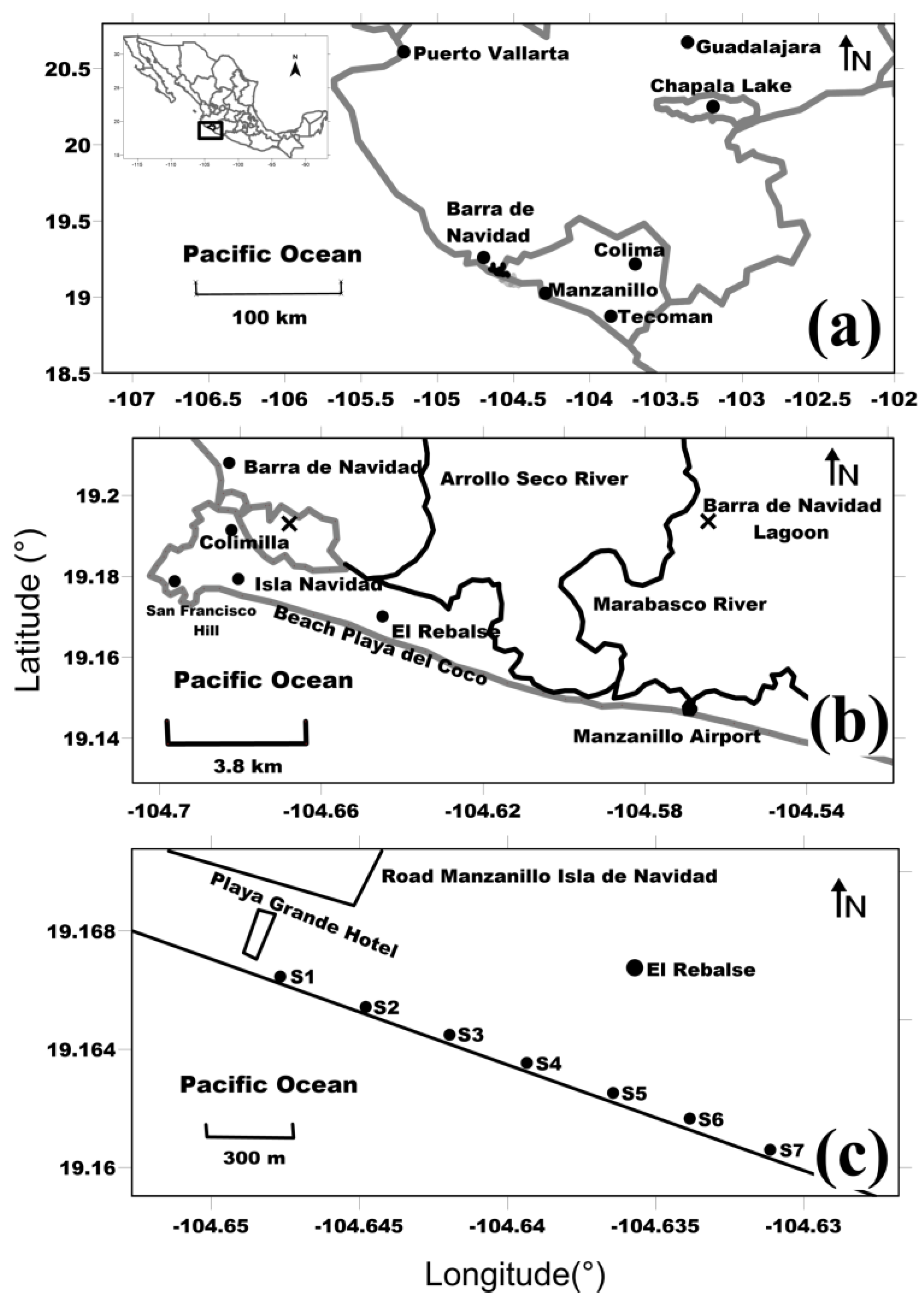


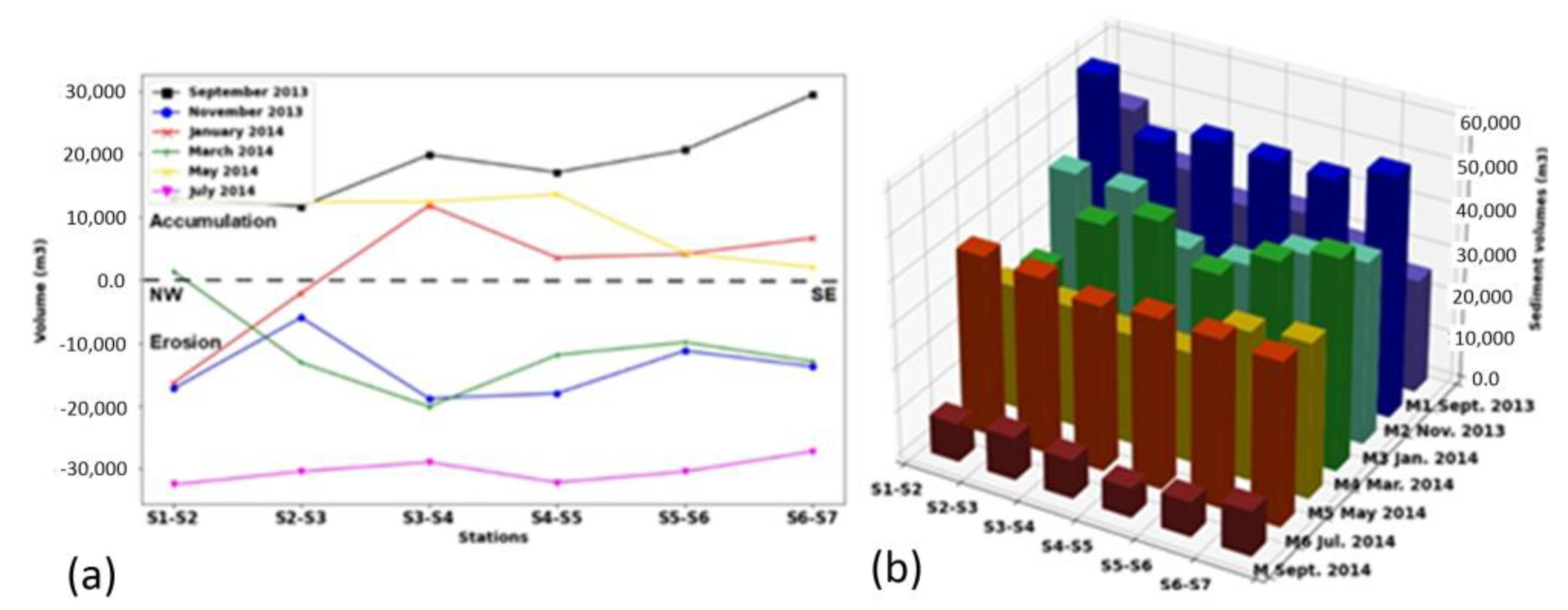


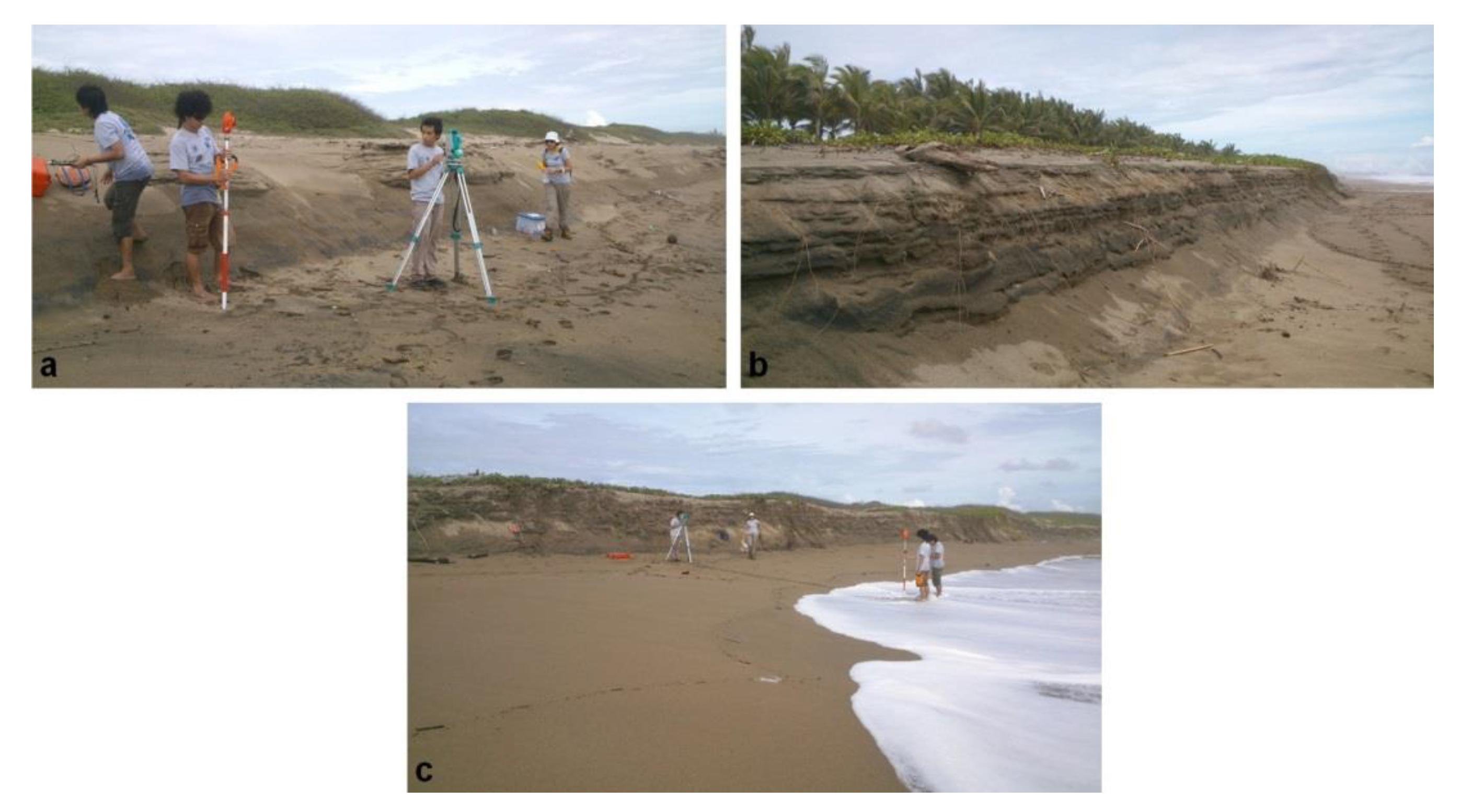
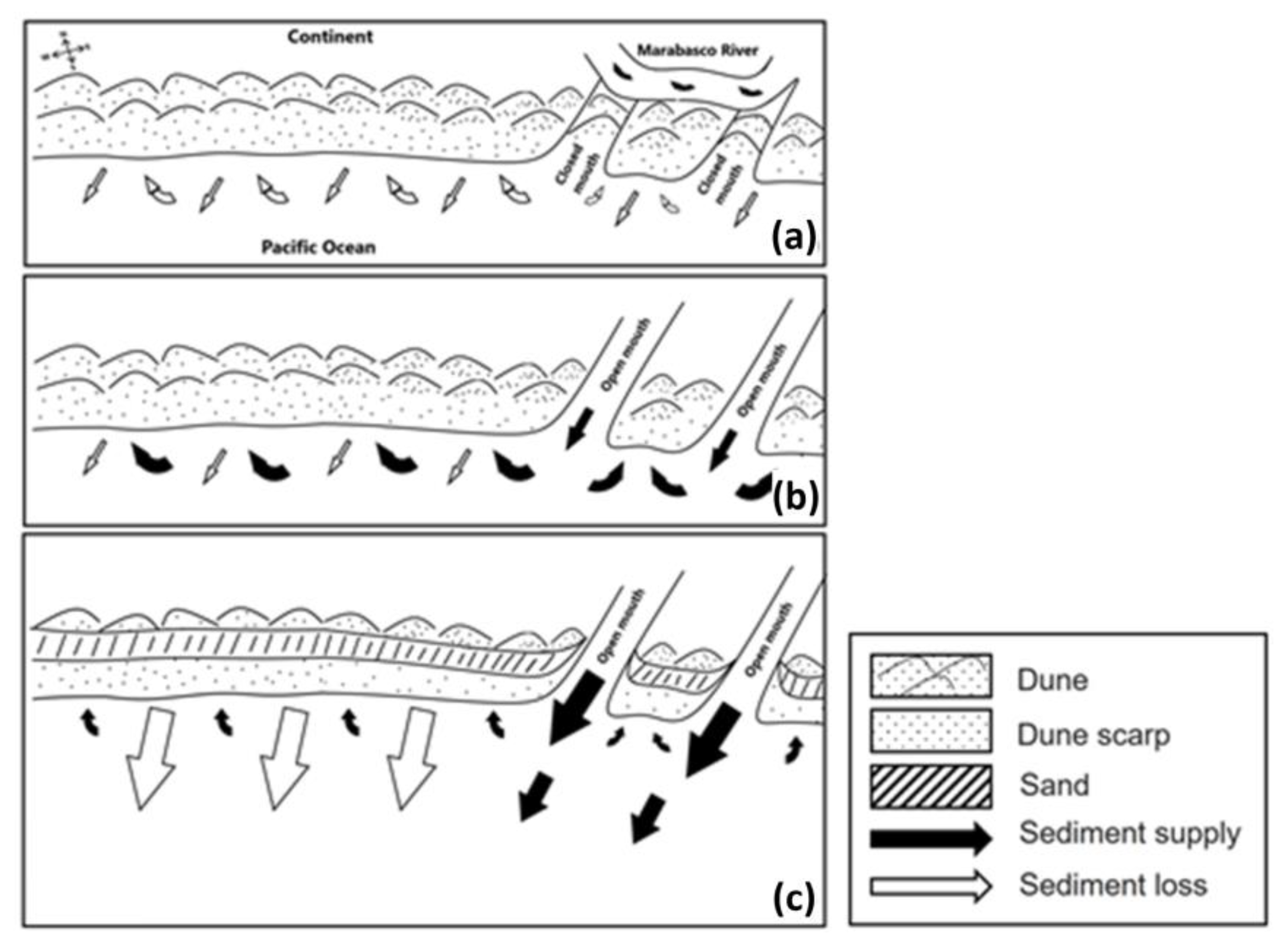
| Station | M1 September 2013 | M2 November 2013 | M3 January 2014 | M4 March 2014 | M5 May 2014 | M6 July 2014 | M7 September 2014 |
|---|---|---|---|---|---|---|---|
| S1 | L | L | L | M | M | M | H |
| S2 | L | M | L | M | L | M | H |
| S3 | M | M | L | M | M | M | H |
| S4 | M | L | M | M | M | M | H |
| S5 | M | M | M | M | L | M | H |
| S6 | M | M | L | M | M | M | H |
| S7 | M | L | L | M | L | M | H |
| Station | M1 September 2013 | M2 November 2013 | M3 January 2014 | M4 March 2014 | M5 May 2014 | M6 July 2014 | M7 September 2014 |
|---|---|---|---|---|---|---|---|
| S1–S2 | 47,836 | 60,850 | 43,575 | 27,198 | 28,527 | 41,362 | 8850 |
| S2–S3 | 37,329 | 49,008 | 43,051 | 40,990 | 27,861 | 40,264 | 9826 |
| S3–S4 | 32,329 | 52,498 | 33,670 | 45,520 | 25,399 | 37,821 | 8874 |
| S4–S5 | 34,630 | 51,747 | 33,723 | 37,276 | 25,366 | 38,979 | 6793 |
| S5–S6 | 30,484 | 51,157 | 39,918 | 44,046 | 34,149 | 38,434 | 7974 |
| S6–S7 | 26,143 | 55,629 | 41,866 | 48,525 | 35,559 | 37,555 | 10,323 |
| Sampling Date | Name | Duration | Minimal Distance to Study Area | Type | Wind Speed |
|---|---|---|---|---|---|
| M1 September 2013 | Lorena | 5–7 September 2013 | 232 km SW from Manzanillo | Tropical Storm | 83 km/h |
| Manuel | 13–19 September 2013 | 509 km SE from Manzanillo | Hurricane (I) | 120 km/h | |
| M2 November 2013 | Calm season | ||||
| M3 January 2014 | Calm season | ||||
| M4 March 2014 | Calm season | ||||
| M5 May 2014 | Amanda | 22–29 May 2014 | 1005 km SE from Manzanillo | Hurricane (III) | 195 km/h |
| M6 July 2014 | Cristina | 9–16 June 2014 | 375 km SSW from Manzanillo | Hurricane (II) | 155 km/h |
| Douglas | 28 June—5 July 2014 | 525 km SSW from Manzanillo | Tropical Storm | 55 km/h | |
| Elida | 30 June—2 July 2014 | 195 km SSE from Manzanillo | Tropical Storm | 85 km/h | |
| Hernan | 26–29 July 2014 | 580 km SW from Manzanillo | Tropical Storm | 85 km/h | |
| Karina | 13–26 August 2014 | 370 km SW from Manzanillo | Tropical Depression | 55 km/h | |
| Marrie | 21–29 August 2014 | 555 km SSW from Manzanillo | Hurricane (I) | 148 km/h | |
| M7 September 2014 | Norbert | 2–8 September 2014 | 230 km W from Manzanillo | Tropical Storm | 75 km/h |
| Odile | 10–18 September 2014 | 260 km W from Manzanillo | Hurricane (III) | 175 km/h | |
| Polo | 16–22 September 2014 | 215 km W from Manzanillo | Tropical Storm | 110 km/h |
| Station | September–November 2013 | November–January 2013–2014 | January–March 2014 | March–May 2014 | May–July 2014 | July–September 2014 |
|---|---|---|---|---|---|---|
| S1–S2 | 13,014 | −17,275 | −16,377 | 1374 | 12,790 | −32,512 |
| S2–S3 | 11,679 | −5956 | −2061 | −13,129 | 12,403 | −30,438 |
| S3–S4 | 19,923 | −18,828 | 11,850 | −20,121 | 12,421 | −28,947 |
| S4–S5 | 17,116 | −18,024 | 3553 | −11,910 | 13,612 | −32,185 |
| S5–S6 | 20,673 | −11,239 | 4128 | −9897 | 4285 | −30,460 |
| S6–S7 | 29,485 | −13,762 | 6658 | −12,966 | 1996 | −27,232 |
Publisher’s Note: MDPI stays neutral with regard to jurisdictional claims in published maps and institutional affiliations. |
© 2022 by the authors. Licensee MDPI, Basel, Switzerland. This article is an open access article distributed under the terms and conditions of the Creative Commons Attribution (CC BY) license (https://creativecommons.org/licenses/by/4.0/).
Share and Cite
Zuber, A.; Álvarez, M.-C.; Mendoza, E.; Díaz-Flores, M.Á.; Galicia-Pérez, M.; Torres-Orozco, E. Monitoring Beach Shape Development and Sediment Dynamics on a Sandy Beach with Low Anthropogenic Influence. Land 2022, 11, 2219. https://doi.org/10.3390/land11122219
Zuber A, Álvarez M-C, Mendoza E, Díaz-Flores MÁ, Galicia-Pérez M, Torres-Orozco E. Monitoring Beach Shape Development and Sediment Dynamics on a Sandy Beach with Low Anthropogenic Influence. Land. 2022; 11(12):2219. https://doi.org/10.3390/land11122219
Chicago/Turabian StyleZuber, Alain, María-Carmen Álvarez, Edgar Mendoza, Miguel Ángel Díaz-Flores, Marco Galicia-Pérez, and Ernesto Torres-Orozco. 2022. "Monitoring Beach Shape Development and Sediment Dynamics on a Sandy Beach with Low Anthropogenic Influence" Land 11, no. 12: 2219. https://doi.org/10.3390/land11122219
APA StyleZuber, A., Álvarez, M.-C., Mendoza, E., Díaz-Flores, M. Á., Galicia-Pérez, M., & Torres-Orozco, E. (2022). Monitoring Beach Shape Development and Sediment Dynamics on a Sandy Beach with Low Anthropogenic Influence. Land, 11(12), 2219. https://doi.org/10.3390/land11122219







